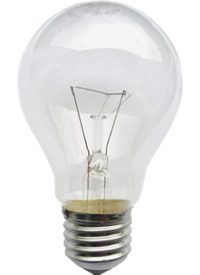
In 2007, President George W. Bush signed into law an amendment, intended as a means to save energy and limit pollution, that will ban the incandescent light bulb effective January 1, 2014. Republican lawmakers have been tirelessly working to repeal the ban before it takes effect. In the meantime, however, companies are moving forward as if the ban is permanent. Two makers of lighting products have already produced LED bulbs that are said to be bright enough to replace the 100-watt incandescent bulbs, but there is a catch: the replacement bulbs are approximately $50 each. The new light technology will be on display at the LightFair trade show in Philadelphia this week.
The 2007 law mandated that light bulbs producing more than 100 watts of light meet efficiency standards, starting in 2012. Because conventional light bulbs do not meet those goals, they will be prohibited. In 2014, the same rule will apply to any bulb above 40 watts.
The Blaze explains the reasoning behind the law:
The technology in traditional “incandescent” bulbs is more than a century old. Such bulbs waste most of the electricity that feeds them, turning it into heat. The 100-watt bulb, in particular, produces so much heat that it’s used in Hasbro’s Easy-Bake Oven.
Some have already embraced the 2007 law. California, for example, has banned stores from restocking any 100-watt bulbs.
Unfortunately, finding a replacement for the incandescent light bulb is a more complicated task than originally expected, particularly because the new bulbs must now fit into fixtures and lamps designed for older technology.
Liberals have touted the compact fluorescents as a viable alternative, seemingly ignoring the many serious problems associated with them — most notably, the presence of toxic mercury vapor within the CFLs. The New American’s Daniel Sayani explains:
CFLs have powerful radiation-emitting electromagnetic fields which expose people to “dirty electricity,” which can lead to a fivefold increase in cancer; furthermore, because they are composed of mercury vapor, broken CFLs can be deadly, as users are exposed to possible mercury poisoning. In addition, the bulbs have been linked to severe neurological damage, as they can result in migraine and epilepsy attacks.
In addition to the many potential health risks associated with the CFLs, the Wall Street Journal reports that the promised longevity of the bulbs has been exaggerated by over 30 percent.
The organic light-emitting diodes (OLEDs), another new lighting technology, have had problems with mass production. The Blaze writes:
OLEDs are glowing sheets or tiles, rather than pinprick light sources, as LEDs are. They’re used as vibrant color screens for smartphones, particularly from Samsung Electronics Co.
But making OLEDs that are big, bright, cheap and long-lasting enough for use as light sources has proved difficult, in part because they use chemicals that are sensitive to oxygen and spoil unless sealed very carefully.
Several OLEDs, produced by Acuity Brands, Inc., will be on display at the Philadelphia light show. The diodes are expected to go on sale next year, but their expense will likely prohibit them from becoming everyday household items.
LEDs, while efficient, durable, and easily mass-produced, are quite expensive: more than $40. Furthermore, the LEDs produce heat, which shortens their lifespan and reduces the efficiency of the diodes. The problems increase as the bulb gets brighter.
The most powerful of the LEDs is equivalent to the 60-watt bulb, but the lighting company Osram Sylvania has announced that it overcame the heat problem and will be unveiling a pear-shaped 100-watt-equivalent LED bulb at the light show. Additionally, Osram Sylvania’s 75-watters will be available at Lowe’s in July. Royal Phillips Electronics NV will have the 75-watt bulbs in stores later this year as well, priced between $40 and $45.
Likewise, the Lighting Sciences Group Corp. will be showing a number of 100-watt-equivalent light bulbs at the LightFair, including some that cool the LEDs through microscopic devices similar to miniature fans which move air through the chips.
The federal government has implemented a program to help stimulate the development of LEDs. The $10 million “L-Prize” will be awarded to any company which can produce an energy-efficient replacement for the 60-watt light bulb, as it is the most common. A significant obstacle for interested firms, however, is that the L-Prize target cost is $22, significantly lower than the $40-50 range of most companys’ new bulbs.
Still, the Department of Energy expects a 60-watt equivalent to cost approximately $10 by the year 2015, within the same price range as the compact fluorescent bulb.
Meanwhile, Republican lawmakers have voiced intense opposition to the lighting regulations. Senator Mike Enzi (R-Wyo.) and Senator Jim DeMint (R-S.C.) have introduced the BULB Act, legislation to reverse the ban on the incandescent light bulbs. DeMint indicates, “Washington needs to stop picking winners and losers in the marketplace and micromanaging how Americans live their lives. Americans are fully capable of choosing the best way to light their own homes and what best fits the needs and budget of their families.”
Senator Enzi asserts that the principles of the free market system would best dictate the winners and losers:
I think it’s fine if someone wants to fill their home or business with the light from the [CFLs]. I also think it’s fine if someone wants to buy an old-fashioned bulb because it works better for them. If left alone, the best bulb will win its rightful standing in the marketplace. Government doesn’t need to be in the business of telling people what light bulb they have to use.
Little progress has been made on Enzi’s and DeMint’s BULB Act, which has been stuck in the Committee on Energy and Natural Resources since March.
Similarly, Representative Michele Bachmann (R-Minn.) reintroduced her signature “Light Bulb Freedom of Choice Act” in March, which also seeks to repeal the ban of the incandescent light bulbs. Her bill was referred to the Subcommittee on Energy and Power on March 8, and has seen no further action since that date.




